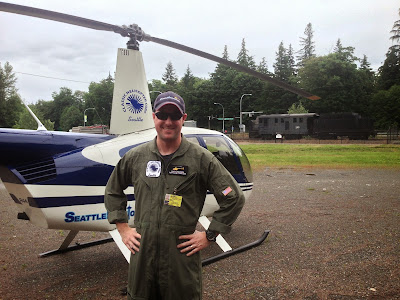 |
| Santana Hackler, Welding Technology Graduate |
Today's successful profile features a Q and A with Santana Hackler. Santana is a Workforce Education student who is enrolled in the Welding program at Green River. He's earned multiple certificates and now has his sights set on completing an Associate in Applied Science degree. His welding expertise, mixed with extensive salvage experience and a background in deep-sea diving, will make Santana a triple threat on the job market. He credits Green River's Welding program for its diversity, level of engagement, and its dynamic mix of theory and practice. Check out his story below!
Hi Santana. Thanks for joining us on the blog. What's it like to be a student in the Welding program at Green River?
Santana: Well, being a student here at Green River is a life-changing experience, something that will stay with me for a lifetime. The Welding program has been a real personal challenge that has grown me as a student and as a future employee. The whole Welding program is designed to challenge you on every level of the trade, so anyone can come in and learn how to weld, and understand the processes that employers desire from their well-trained welders. The program, as a whole, is the most inviting and pleasant program I could be involved in at Green River. The diversity of people, the level of engaging welding, and the theory practices within my program have opened many doors of capability and opportunity.
Can you tell us the story of how you decided to pursue training in this field?
Santana: I decided to pursue welding training at Green River because I wanted job security. I put a lot of time and thought into my choice of career field, because the job field was changing due to the economy. After talking with a career adviser at Green River, we found that welding is an area where I have previous skill sets because of my extensive salvage and deep-sea diver training. So, the choice was a natural one, after I had spoken with Professor E. Vessor who took the time to explain how the program worked and what I could expect. From day one, I knew Green River was my ticket to success.
How has Workforce Education helped you towards completing your goals?
Santana: Workforce Education has been a true godsend in helping me realize my dream from start to finish. It brings me to tears knowing there are programs like theirs that can actually help transform people's lives, and give them an opportunity to realize their dreams. From day one, Workforce helped me in the whole process, from Compass testing, and getting into classes, to acquiring equipment to weld with. I owe the success, in all I'm doing at Green River, to Workforce; they gave me a real fighting chance to make a difference for the lives of me and my loved ones. When I think of Workforce, I think of family, because that's how they treated me. And for that, I'm graduating college. The chance I got from Workforce was a chance to change for a lifetime.
You've completed two certificates, and are approaching completion of an Associate of Applied Science degree in Welding--congrats! What advice do you have for new students who are thinking about pursuing Welding training at Green River?
Santana: My advice for people who want welding training at Green River would be to approach each day as a new opportunity to add something positive and challenging to your day. Make the most of this opportunity, and the doors that you will open, by undertaking a career in welding, will change your life. Better benefits and rewards in your career will be a direct result of the fact that you chose to change your life by becoming an industry welder.
Funding Tip! All four Workforce Education funding programs--BFET, Opportunity Grant, Worker Retraining, and WorkFirst--support Welding at Green River.









